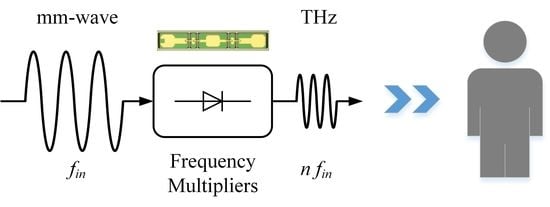The Development of Frequency Multipliers for Terahertz Remote Sensing System
Abstract
:1. Introduction
2. Diode Component
2.1. Diode Structure
2.2. Diode Manufacturing
- (1)
- In the first step, a photoresistance layer is spin-coated onto the surface of the wafer and dried. Before spin coating, surface hydrophobization is used to improve the adhesion of the wafer surface to the photoresistance layer, which involves vaporized hexamethyldisilazane (HMDS, (CH3)3SiNHSi(CH3)3). HMDS replaces the hydrophilic hydroxide radicals (OH−) on the wafer surface with hydrophobic OSi(CH3)3− for pre-treatment;
- (2)
- In the second step, the dried wafer is exposed in a photolithography machine to stimulate a photochemical reaction. With the development of photolithography technology, the exposure method gradually progresses from a full-silicon exposure to a step-and-repeat exposure and a step-and-scan exposure. The all-silicon 1:1 exposure method is a simpler process and does not require a highly monochromatic light source. However, due to its precision, the step exposure mode has become the de facto method of fabrication due to its reduced magnification exposure mode.
- (3)
- In the third step, the exposed wafer is baked for the second time in a post-exposure baking (PEB) process. The photosensitive elements generated during the exposure process are diffused during baking. The photoresist forms a latent image consistent with the photoresist mask.
- (4)
- Finally, the exposure pattern is developed via spraying or soaking in a developer solution. The developer solution is generally a strong alkaline solution, such as tetra methyl ammonium hydroxide (TMAH, (CH3)4NHO). The latent image is washed away by the developer and the mask pattern is displayed on the photoresistance layer. Another baking cycle can be performed after development to remove the moisture in the photoresistance layer.
- (1)
- In the first step, the diode mesa is formed using etching technology (Figure 4b). According to the diode design, the extra epitaxial part outside the mesa can be removed by chemical etching or plasma etching. The chemical corrosion process has the advantages of simplicity and low cost. However, isotropic etching using solution can cause additional lateral corrosion. Plasma etching with anisotropic etching characteristics is a good manufacturing technology for small-sized structures. Chemical etching can directly use the photoresistance layer as a mask. Plasma etching requires the deposition of a layer of oxide film with a high etching selectivity ratio to serve as a mask; the mask is removed after the etching is completed.
- (2)
- The etching method of the diode mesa can be selected according to the design requirements. A thin dielectric film is deposited to achieve passivation of the semiconductor material, as shown in Figure 4c. Depositing a dielectric film on the surface of the epitaxial layer can effectively protect the surface structure of the semiconductor material. Meanwhile, the dielectric film around the anode can reduce the diode leakage effects during circuit operation. Silicon oxide films and silicon nitride films are widely used dielectric films for the diode manufacturing process. The thickness of the dielectric is generally 1000 Å to 2000 Å, while the dielectric film is deposited by thermal oxidation, chemical vapor deposition (CVD) and atomic layer deposition (ALD). Silicon oxide films and silicon nitride films are widely used electrolyte films in the diode manufacturing process.
- (3)
- The diode cathode ohmic contact is formed by etching and metal deposition, as shown in Figure 4d. The ideal ohmic contact is an essential part of the diode. The specific contact ohmic contact resistance Rc is expressed as:where is the barrier height, is the normalized doping concentration, k is the Coulomb constant, T is the absolute temperature, q is the electron charge magnitude, A is the cross-sectional area, is the reduced Planck’s constant, N is the impurity concentration and is the effective mass of the electrons and holes (assumed to be approximately constant near the temperature T). The pi constant is π. Since kT << E00, the field emission (FE) near the Fermi level plays a dominant role during current transport and is associated with a pure tunneling process. A high doping concentration and low barrier height are measures to achieve low ohmic resistance. Using photolithography, the photoresistance layer on the surface of the epitaxial layer appears in a sequence of grooves with the same morphology as the cathode metal. The epitaxial layer at the grooves is removed using etching technology and a highly doped (1 × 1018–1 × 1019 cm−3) buffer layer is deposited. The ohmic metal layer is using atomic layer deposition (ALD) or radio frequency physical vapor deposition (RFPVD) methods. Annealing can effectively reduce the work required to construct system elements. The Ni/Ge/Au system is used to obtain ohmic contact resistance under annealing conditions. The anode Schottky contact is achieved via metal deposition, as shown in Figure 4e. There is a difference between the work function of the anode metal of the Schottky diode and the Fermi energy of the epitaxial layer. This difference forms a Schottky barrier at the contact surface, and this means the anode current of the Schottky diode is mostly based on thermionic emission (TE). A low metal work function and high epitaxial layer Fermi levels can reduce the height of the Schottky barrier. The thickness of the metal forming the Schottky contact is generally selected to be between 50 Å to 100 Å to obtain a relatively stable work function. Similar to the production of ohmic metal, the photoresistance layer on the surface of the epitaxial layer has grooves with the same morphology as the anode metal. The Ai/Pt/Au metal system can form a Schottky barrier of 0.6 eV to 0.7 eV for the GaAs Schottky diode. Note that the Schottky metal elements are made after the dielectric and ohmic metal elements to avoid barrier reduction of the Schottky metal at high temperatures associated with the process. This is a key breakthrough in ensuring the barrier height of the Schottky junction.
- (4)
- Finally, metal interconnection and pad production are achieved via electroplating, as shown in Figure 4f. The electroplating process generally utilizes a double-layer photoresistance stak. Both layers of photoresistance material have grooves with the same topography as the electroplated metal. A plating seed layer such as Ti/Au (titanium/gold) is deposited using the RFPVD method between two layers of photoresistance material, and this provides an adequate current path for electroplating. An accelerator, suppressor and leveler chemicals are often added to the electroplating solution to improve the leveling of the electroplated metal. After the electroplating, the photoresistance material and the seed layer are etched and removed, and the desired pattern is obtained.
3. Diode Model
3.1. Parasitic Models
3.2. Intrinsic Model
4. Design Methodology of Frequency Multipliers
5. The Development of Terahertz Frequency Multipliers
6. Terahertz Remote Sensing System
6.1. Remote Sensing Applications
6.2. Development of a 220 GHz Imaging System
7. Conclusions
Author Contributions
Funding
Data Availability Statement
Conflicts of Interest
References
- Siegel, P.H. Terahertz technology. IEEE Trans. Microw. Theory Tech. 2002, 50, 910–928. [Google Scholar] [CrossRef]
- Song, H.; Nagatsuma, T. Present and Future of Terahertz Communications. IEEE Trans. Terahertz Sci. Technol. 2011, 1, 256–263. [Google Scholar] [CrossRef]
- Woolard, D.L.; Brown, R.; Pepper, M.; Kemp, M. Terahertz Frequency Sensing and Imaging: A Time of Reckoning Future Applications? IEEE 2005, 93, 1722–1743. [Google Scholar] [CrossRef]
- Dong, P.; Liu, L.; Li, S.; Hu, S.; Bu, L. Application of M5 Model Tree in Passive Remote Sensing of Thin Ice Cloud Microphysical Properties in Terahertz Region. Remote Sens. 2021, 13, 2569. [Google Scholar] [CrossRef]
- Hosako, I.; Sekine, N.; Patrashin, M.; Saito, S.; Fukunaga, K.; Kasai, Y.; Baron, P.; Seta, T.; Mendrok, J.; Ochiai, S.; et al. At the Dawn of a New Era in Terahertz Technology. IEEE 2007, 95, 1611–1623. [Google Scholar] [CrossRef]
- Wells, J. Faster than fiber: The future of multi-G/s wireless. IEEE Microw. Mag. 2009, 10, 104–112. [Google Scholar] [CrossRef]
- Han, R.; Zhang, Y.; Kim, Y.; Zhang, Y.M.; Kim, Y.; Kim, D.Y.; Shichijo, H.; Afshari, E.; Kenneth, K.O. Active terahertz imaging using Schottky diodes in CMOS: Array and 860-GHz pixel. IEEE J. Solid-State Circuits 2013, 48, 2296–2308. [Google Scholar] [CrossRef]
- Zhan, H.; Li, Q.; Zhao, K.; Zhang, L.W.; Zhang, Z.W.; Zhang, C.L.; Xiao, L.Z. Evaluating PM2.5 at a Construction Site Using Terahertz Radiation. IEEE Trans. Terahertz Sci. Technol. 2015, 5, 1028–1034. [Google Scholar] [CrossRef]
- Liu, H.B.; Zhong, H.; Karpowicz, N.; Chen, Y.; Zhang, X.C. Terahertz Spectroscopy and Imaging for Defense and Security Applications. IEEE 2007, 95, 1514–1527. [Google Scholar] [CrossRef]
- Fan, L.; Zeng, Y.; Yang, Q.; Wang, H.Q.; Deng, B. Fast and High-Quality 3-D Terahertz Super-Resolution Imaging Using Lightweight SR-CNN. Remote Sens. 2021, 13, 3800. [Google Scholar] [CrossRef]
- Li, H.; Li, C.; Wu, S.; Zheng, S.; Fang, G.Y. Adaptive 3D Imaging for Moving Targets Based on a SIMO InISAR Imaging System in 0.2 THz Band. Remote Sens. 2021, 13, 782. [Google Scholar] [CrossRef]
- Federici, J.F.; Schulkin, B.; Huang, F.; Gary, D.; Barat, R.; Oliveira, F.; Zimdars, D. THz imaging and sensing for security applications—Explosives, weapons and drugs. Semicond. Sci. Technol. 2005, 20, S266. [Google Scholar] [CrossRef]
- Goossens, S.; Navickaite, G.; Monasterio, C.; Gupta, S.; Piqueras, J.J.; Perez, R.; Burwell, G.; Nikitskiy, I.; Lasanta, T. Broadband image sensor array based on graphene–CMOS integration. Nat. Photon. 2017, 11, 366–371. [Google Scholar] [CrossRef]
- Liu, J.; Dai, J.; Chin, S.L.; Zhang, X.C. Broadband terahertz wave remote sensing using coherent manipulation of fluorescence from asymmetrically ionized gases. Nat. Photon. 2010, 4, 627–631. [Google Scholar] [CrossRef]
- Saeedkia, D. Handbook of Terahertz Technology for Imaging, Sensing and Communications; Elsevier: Aalborg, Denmark, 2013. [Google Scholar]
- Cooper, K.B.; Dengler, R.J.; Chattopadhyay, G.; Schlecht, E.; Gill, J.; Skalare, A.; Mehdi, I.; Siegel, P.H. A High-Resolution Imaging Radar at 580 GHz. IEEE Microw. Wirel. Compon. Lett. 2008, 18, 64–66. [Google Scholar] [CrossRef]
- Chan, W.L.; Charan, K.; Takhar, D.; Kelly, K.F.; Baraniuk, R.G.; Mittleman, D.M. A single-pixel terahertz imaging system based on compressed sensing. Appl. Phys. Lett. 2008, 93, 121105. [Google Scholar] [CrossRef] [Green Version]
- Crowe, T.W.; Bishop, W.L.; Porterfield, D.W.; Hesler, J.L.; Weikle, R.M. Opening the terahertz window with integrated diode circuits. IEEE J. Solid-State Circuits 2005, 40, 2104–2110. [Google Scholar] [CrossRef]
- Chattopadhyay, G. Technology, Capabilities, and Performance of Low Power Terahertz Sources. IEEE Trans. Terahertz Sci. Technol. 2011, 1, 33–53. [Google Scholar] [CrossRef]
- Gronqvist, H.R.; Kollberg, E. Millimeter- and submillimeter-wave multipliers using quantum-barrier-varactor (QBV) diodes. IEEE Electron Device Lett. 1990, 11, 373–375. [Google Scholar] [CrossRef]
- Esaki, L.; Tsu, R. Superlattice and Negative Differential Conductivity in Semiconductors. IBM J. Res. Dev. 1970, 14, 61–65. [Google Scholar] [CrossRef]
- Esaki, L. Discovery of the tunnel diode. IEEE Trans. Electron Devices 1976, 23, 644–647. [Google Scholar] [CrossRef]
- Jones, J.R.; Bishop, W.L.; Jones, S.H.; Tait, G.B. Planar multibarrier 80/240-GHz heterostructure barrier varactor triplers. IEEE Trans. Microw. Theory Tech. 1997, 45, 512–518. [Google Scholar] [CrossRef]
- Stake, J.; Malko, A.; Bryllert, T.; Vukusic, J. Status and Prospects of High-Power Heterostructure Barrier Varactor Frequency Multipliers. IEEE 2017, 105, 1008–1019. [Google Scholar] [CrossRef] [Green Version]
- Vukusic, J.; Bryllert, T.; Emadi, T.A.; Sadeghi, M.; Stake, J. A 0.2-W Heterostructure Barrier Varactor Frequency Tripler at 113 GHz. IEEE Electron Device Lett. 2007, 28, 340–342. [Google Scholar] [CrossRef] [Green Version]
- Vukusic, J.; Bryllert, T.; Olsen, Ø.; Hanning, J.; Stake, J. Monolithic HBV-Based 282-GHz Tripler with 31-mW Output Power. IEEE Electron Device Lett. 2012, 33, 800–802. [Google Scholar] [CrossRef]
- Dahlbäck, R.; Vukusic, J.; Weikle, R.M.; Stake, J. A Tunable 240–290 GHz Waveguide Enclosed 2-D Grid HBV Frequency Tripler. IEEE Trans. Terahertz Sci. Technol. 2016, 6, 503–509. [Google Scholar] [CrossRef]
- Olsen, A.; Ingvarson, M.; Alderman, B.; Stake, J. A 100-GHz HBV frequency quintupler using microstrip elements. IEEE Microw. Wirel. Compon. Lett. 2004, 14, 493–495. [Google Scholar] [CrossRef]
- Qun Xiao, J.L.; Hesler, D.Y.; Crowe, T.W.; Weikle, R.M. A 300-GHz heterostructure barrier varactor (HBV) frequency septupler. In Proceedings of the 2005 Joint 30th International Conference on Infrared and Millimeter Waves and 13th International Conference on Terahertz Electronics, Williamsburg, VA, USA, 19–23 September 2005; pp. 80–81. [Google Scholar] [CrossRef]
- Alijabbari, N.; Bauwens, M.F.; Weikle, R.M. Design and Characterization of Integrated Submillimeter-Wave Quasi-Vertical Schottky Diodes. IEEE Trans. Terahertz Sci. Technol. 2015, 5, 73–80. [Google Scholar] [CrossRef]
- Zhang, L.; Liang, S.X.; Lv, Y.J.; Yang, D.B.; Fu, X.C.; Song, X.B.; Gu, G.D.; Xu, P.; Guo, Y.M.; Bu, A.M.; et al. High-Power 300 GHz Solid-State Source Chain Based on GaN Doublers. IEEE Electron Device Lett. 2021, 42, 1588–1591. [Google Scholar] [CrossRef]
- Yong, Z.; Chengkai, W.; Wei, J.; Bo, Y.; Ruimin, X. A planar Schottky diode with multi finger structure. China ZL 2019, 1133, 4949. [Google Scholar]
- Jelenski, A.; Grub, A.; Krozer, V.; Hartnagel, H.L. New approach to the design and the fabrication of THz Schottky barrier diodes. IEEE Trans. Microw. Theory Technol. 1993, 41, 549–557. [Google Scholar] [CrossRef]
- Tang, A.Y.; Drakinskiy, V.; Yhland, K.; Stenarson, J.; Bryllert, T.; Stake, J. Analytical Extraction of a Schottky Diode Model from Broadband S-Parameters. IEEE Trans. Microw. Theory Tech. 2013, 61, 1870–1878. [Google Scholar] [CrossRef]
- Hesler, J. Planar Schonly Diodes in Submillimeter Wavelength Waveguide Receivers. Ph.D. Thesis, University of Virginia, Virginia, VA, USA, January 1996. [Google Scholar]
- Wu, C.; Zhang, Y.; Xu, Y.; Bo, Y.; Xu, R. Dual Lumped Ports Technique and Its Applications in Modeling of Planar Schottky Diode in THz Band. IEEE Access 2020, 8, 38001–38009. [Google Scholar] [CrossRef]
- Kolberg, E.L.; Tolmunen, T.J.; Frerking, M.A.; East, J.R. Current saturation in submillimeter-wave varactors. IEEE Trans. Microw. Theory Tech. 1992, 40, 831–838. [Google Scholar] [CrossRef]
- Moro-Melgar, D.; Maestrini, A.; Treuttel, J.; Gatilova, L.; Gonzalez, T.; Vasallo, B.G.; Mateos, J. Monte Carlo Study of 2-D Capacitance Fringing Effects in GaAs Planar Schottky Diodes. IEEE Trans. Electron Devices 2016, 63, 3900–3907. [Google Scholar] [CrossRef]
- Renl, T.; Zhang, Y. A study of the terahertz C-V characteristic of the Schottky barrier diode. In Proceedings of the 2017 IEEE MTT-S International Microwave Symposium (IMS), Honololu, HI, USA, 4–9 June 2017. [Google Scholar] [CrossRef]
- Tang, A.Y.; Schlecht, E.; Lin, R.; Chattopadhyay, G.; Lee, C.; Gill, J.; Mehdi, I.; Stake, J. Electro-Thermal Model for Multi-Anode Schottky Diode Multipliers. IEEE Trans. Terahertz Sci. Technol. 2012, 2, 290–298. [Google Scholar] [CrossRef] [Green Version]
- Pérez-Moreno, C.G.; Grajal, J. Physical Electro-Thermal Model for the Design of Schottky Diode-Based Circuits. IEEE Trans. Terahertz Sci. Technol. 2014, 4, 597–604. [Google Scholar] [CrossRef]
- Orfao, B.; Vasallo, B.G.; Moro-Melgar, D.; Pérez, S.; Mateos, J.; González, T. Analysis of Surface Charge Effects and Edge Fringing Capacitance in Planar GaAs and GaN Schottky Barrier Diodes. IEEE Trans. Electron Devices 2020, 67, 3530–3535. [Google Scholar] [CrossRef]
- Cui, J.; Zhang, Y.; Wei, H.; Wu, Q.; Mao, S.; Xu, Y.; Yan, B.; Xu, R. Electro-Thermal Model for Schottky Barrier Diode Based on Self-Heating Effect. In Proceedings of the IEEE the 4th International Conference on Electronics and Communication Engineering (ICECE), Xi’an, China, 17–19 December 2021. [Google Scholar]
- Cui, J.; Zhang, Y.; Xia, D.J.; Xu, Y.H.; Xiao, F.; Yan, B.; Xu, R.M. A 220 GHz Broadband Sub-Harmonic Mixer Based on Global Design Method. IEEE Access 2019, 7, 30067–30078. [Google Scholar] [CrossRef]
- Chengkai, W. Research on Terahertz Frequency Multiplication Technology Based on Schottky Diode; University of Electronic Science and Technology: Sichuan, China, 2018. [Google Scholar]
- Cui, J.; Wei, H.; Huang, S.; Xie, J.; Li, Y.; Yu, C.; Wang, L.; Zhang, Y. Design of a 270–290 GHz frequency tripler based on the Half-Subdivision and Half-Global Design Method. In Proceedings of the International Conference on Microwave and Millimeter Wave Technology (ICMMT), Nanjing, China, 23–26 May 2021; pp. 1–3. [Google Scholar] [CrossRef]
- Cui, J.; Zhang, Y.; Xu, Y.; Ye, L.; Xiao, F.; Yan, B.; Cui, R. A 200–240 GHz Sub-Harmonic Mixer Based on Half-Subdivision and Half-Global Design Method. IEEE Access 2020, 8, 33461–33470. [Google Scholar] [CrossRef]
- Wu, C.; Zhang, Y.; Long, M.; Xu, Y.; Xu, R. Design of a 110 GHz broadband frequency tripler using planar varistor Schottky diodes. In Proceedings of the IEEE MTT-S International Wireless Symposium (IWS), Guangzhou, China, 19–22 May 2019; pp. 1–3. [Google Scholar] [CrossRef]
- Porterfield, D.W.; Crowe, T.W.; Bradley, R.F.; Erickson, N.R. A high-power fixed-tuned millimeter-wave balanced frequency doubler. IEEE Trans. Microw. Theory Tech. 1999, 47, 419–425. [Google Scholar] [CrossRef]
- Wu, C.; Zhang, Y.; Cui, J.; Li, Y.K.; Xu, Y.H.; Xu, R.M. A 135–190 GHz Broadband Self-Biased Frequency Doubler using Four-Anode Schottky Diodes. Micromachines 2019, 10, 277. [Google Scholar] [CrossRef] [PubMed] [Green Version]
- Viegas, C.; Powell, J.; Liu, H.R.; Sanghera, H.; Donoghue, L.; Huggard, P.G.; Alderman, B. On-Chip Integrated Backshort for Relaxation of Machining Accuracy Requirements in Frequency Multipliers. IEEE Microw. Wirel. Compon. Lett. 2021, 31, 188–191. [Google Scholar] [CrossRef]
- Yang, F. Discrete Schottky diodes based terahertz frequency doubler for planetary science and remote sensing. Microw. Opt. Technol. Lett. 2017, 59, 966–970. [Google Scholar] [CrossRef]
- Chattopadhyay, G.; Schlecht, E.; Ward, J.S.; Gill, J.J.; Javadi, H.H.S.; Maiwald, F.; Medhi, I. An all-solid-state broad-band frequency multiplier chain at 1500 GHz. IEEE Trans. Microw. Theory Tech. 2004, 52, 1538–1547. [Google Scholar] [CrossRef]
- Viegas, C.; Liu, H.R.; Powell, J.; Sanghera, H.; Whimster, A.; Donoghue, L.; Huggard, P.G.; Alderman, B. A 180-GHz Schottky Diode Frequency Doubler with Counter-Rotated E-Fields to Provide In-Phase Power-Combining. IEEE Microw. Wirel. Compon. Lett. 2018, 28, 518–520. [Google Scholar] [CrossRef]
- Dou, J.; Jiang, S.; Xu, J.; Wang, W.B. Design of D-band frequency doubler with compact power combiner. Electron. Lett. 2017, 53, 478–480. [Google Scholar] [CrossRef]
- Siles, J.V.; Maestrini, A.; Alderman, B.; Davies, S.; Wang, H.; Treuttel, J.; Leclerc, E.; Narhi, T.; Goldstein, C. A Single-Waveguide In-Phase Power-Combined Frequency Doubler at 190 GHz. IEEE Microw. Wirel. Compon. Lett. 2011, 21, 332–334. [Google Scholar] [CrossRef]
- Maestrini, A.; Ward, J.S.; Tripon-Canseliet, C.; Gill, J.J.; Lee, C.; Javadi, H.; Attopadhyay, G.C.; Mehdi, I. In-Phase Power-Combined Frequency Triplers at 300 GHz. IEEE Microw. Wirel. Compon. Lett. 2008, 18, 218–220. [Google Scholar] [CrossRef]
- Ding, J.Q.; Maestrini, A.; Gatilova, L.; Shi, S.C. High Efficiency and Powerful 260–340 GHz Frequency Doublers based on Schottky Diodes. In Proceedings of the XXXIIIrd General Assembly and Scientific Symposium of the International Union of Radio Science, Rome, Italy, 29 August–5 September 2020; pp. 1–4. [Google Scholar] [CrossRef]
- Siles, J.V.; Cooper, K.; Lee, C.; Lin, R.; Chattopadhyay, G.; Mehdi, I. A Compact Room-Temperature 510–560 GHz Frequency Tripler with 30-mW Output Power. In Proceedings of the 15th European Radar Conference (EuRAD), Madrid, Spain, 26–28 September 2018; pp. 333–336. [Google Scholar] [CrossRef]
- Khanal, S.; Kiuru, T.; Tang, A.Y.; Saber, M.A.; Mallat, J.; Stake, J.; Narhi, T.; Raisanen, A.V. Thermal characterization of THz Schottky diodes using transient current measurements. IEEE Trans. Terahertz Sci. Technol. 2014, 4, 267–276. [Google Scholar] [CrossRef]
- Xiao, Q.; Hesler, J.L.; Crowe, T.W.; Weikle, R.M.; Duan, Y.W.; Deaver, B.S. High-efficiency heterostructure-barrier-varactor frequency triplers using AlN substrates. In Proceedings of the IEEE MTT-S International Microwave Symposium Digest, Long Beach, CA, USA, 17 June 2005; pp. 443–446. [Google Scholar]
- Chen, Z.; Wang, H.; Alderman, B.; Huggard, P.; Zhang, B.; Fan, Y. 190 GHz high power input frequency doubler based on Schottky diodes and AlN substrate. IEICE Electron. Express 2016, 13, 20160981. [Google Scholar] [CrossRef] [Green Version]
- Lee, C.; Ward, J.; Lin, R.; Schlecht, E.; Chattopadhyay, G.; Gill, J.; Thomas, B.; Maestrini, A.; Mehdi, I.; Siegel, P. A wafer-level diamond bonding process to improve power handling capability of submillimeter-wave Schottky diode frequency multipliers. In Proceedings of the 2009 IEEE MTT-S International Microwave Symposium Digest, Boston, MA, USA, 7–12 June 2009; Volume 45, pp. 957–960. [Google Scholar]
- Lee, C.; Ward, J.; Lin, R.; Schlecht, E.; Chattopadhyay, G.; Gill, J.; Thomas, B.; Maestrini, A.; Mehdi, I.; Siegel, P. Diamond heat spreaders for submillimeter-wave gas Schottky diode frequency multipliers. Int. Symp. Space Terahertz Technol. 2009, 2009, 43–46. [Google Scholar]
- Alderman, B.; Manju, H.; Hoshiar, S.; Hui, W.; Simon, R.; Brian, E.; Peter, d.M. Schottky diode technology at Rutherford Appleton Laboratory. In Proceedings of the IEEE International Conference on Microwave Technology and Computational Electromagnetics, Beijing, China, 22–25 May 2011; pp. 4–6. [Google Scholar]
- Liang, S.; Song, X.; Zhang, L.; Lv, Y.J.; Wang, Y.G.; Wei, B.H.; Guo, Y.M.; Gu, G.D.; Wang, B.; Cai, S.J.; et al. A 177–183 GHz high-power GaN-based frequency doubler with over 200 mW output power. IEEE Electron Device Lett. 2020, 41, 669–672. [Google Scholar] [CrossRef]
- Liang, S.; Fang, Y.; Xing, D.; Zhang, Z.R.; Wang, J.L.; Guo, H.Y.; Zhang, L.S.; Gu, G.D.; Feng, Z.H. GaN planar Schottky barrier diode with cut-off frequency of 902 GHz. Electron. Lett. 2016, 52, 1408–1410. [Google Scholar] [CrossRef]
- Min, Y.; Zhang, B.; Fan, Y.; Liang, X.S.; Xing, D.; Wang, J.L. The design of 110GHz frequency tripler using GaN-based planar Schottky diodes. In Proceedings of the IEEE 9th UK-Europe-China Workshop on Millimetre Waves and Terahertz Technologies (UCMMT), Liverpool, UK, 5–7 September 2016; pp. 92–93. [Google Scholar]
- Viegas, C.; Alderman, B.; Pérez-Moreno, C.G.; Powell, J.; Duff, C.I.; Sloan, R. Design and thermal analysis of a high-power frequency doubler at 160 GHz. In Proceedings of the 2016 IEEE MTT-S International Microwave and RF Conference (IMaRC), New Delhi, India, 5–9 December 2016. [Google Scholar] [CrossRef]
- Guo, C.; Shang, X.B.; Lancaster, M.J.; Xu, J.; Powell, J.; Wang, H.; Alderman, B.; Huggard, P.G. A 135–150-GHz Frequency Tripler with Waveguide Filter Matching. IEEE Trans. Microw. Theory Tech. 2018, 66, 4608–4616. [Google Scholar] [CrossRef]
- Siles, J.V.; Cooper, K.B.; Lee, C.; Lin, R.H.; Chattopadhyay, G.; Mehdi, I. A New Generation of Room-Temperature Frequency-Multiplied Sources with up to 10× Higher Output Power in the 160-GHz–1.6-THz Range. IEEE Trans. Terahertz Sci. Technol. 2018, 8, 596–604. [Google Scholar] [CrossRef]
- Dengler, R.J.; Cooper, K.B.; Chattopadhyay, G.; Mehdi, I.; Siegel, P.H. 600 GHz Imaging Radar with 2 cm Range Resolution. Int. Microw. Symp. IEEE 2017, 54, 47–50. [Google Scholar]
- Sheen, D.M.; Hall, T.E.; Severtsen, R.H.; Mcmakin, D.L.; Valdez, P. Standoff concealed weapon detection using a 350-GHz radar imaging system. SPIE Int. Soc. Opt. Eng. 2017, 7670, 115–118. [Google Scholar]
- Liu, F.; Cui, W.; Zhu, Z.; Dong, S.; Shang, S.; Yao, Z. The spaceborne terahertz remote sensing techniques. IET Int. Radar Conf. 2013, 2013. 32, 54–58. [Google Scholar]
- Wu, C.; Zhang, Y.; Li, Y.; Zhu, H.; Xiao, F.; Yan, B.; Xu, R. Millimeter-Wave Waveguide-to-Microstrip Inline Transition Using a Wedge-Waveguide Iris. IEEE Trans. Microw. Theory Tech. 2022, 70, 1087–1096. [Google Scholar] [CrossRef]
- Zhang, Y.; Li, Y.; Chen, Y.; Zhu, H. The development of the package of the Terahertz integrated circuits. In Proceedings of the IEEE Asia-Pacific Microwave Conference (APMC), Marina Bay Sands, Singapore, 10–13 December 2019; pp. 625–627. [Google Scholar] [CrossRef]
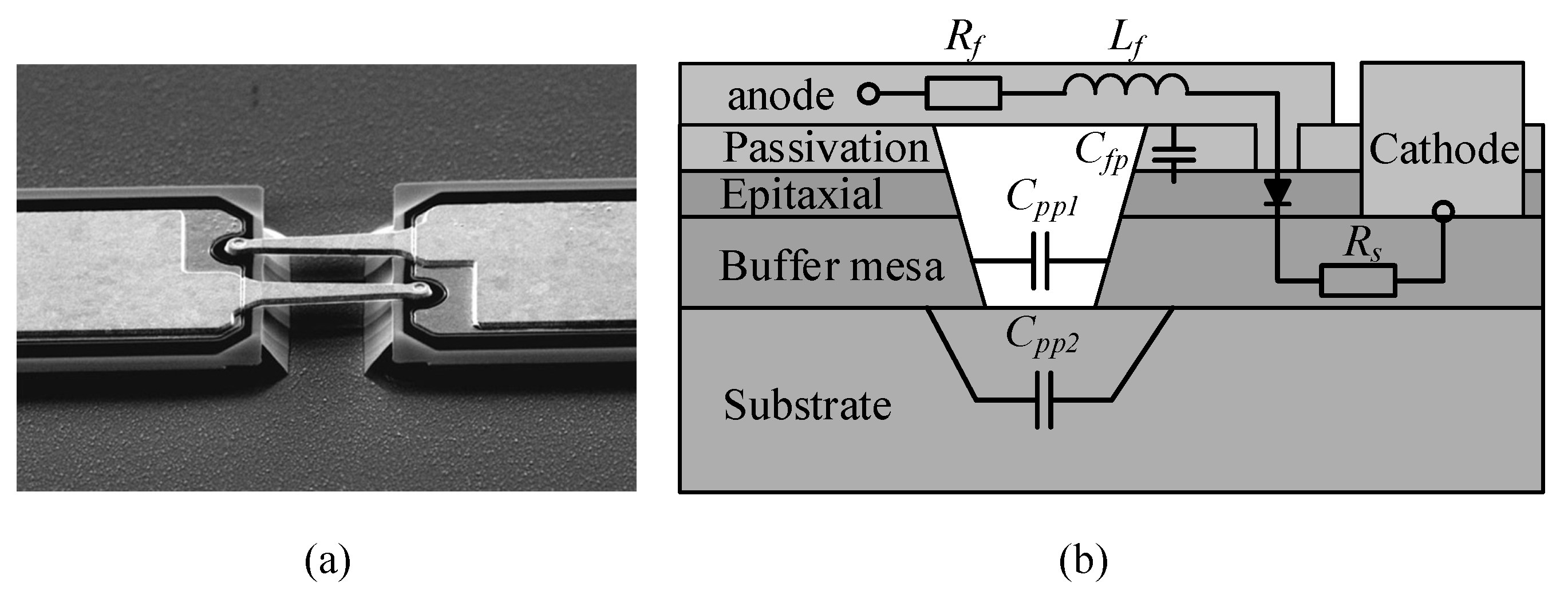


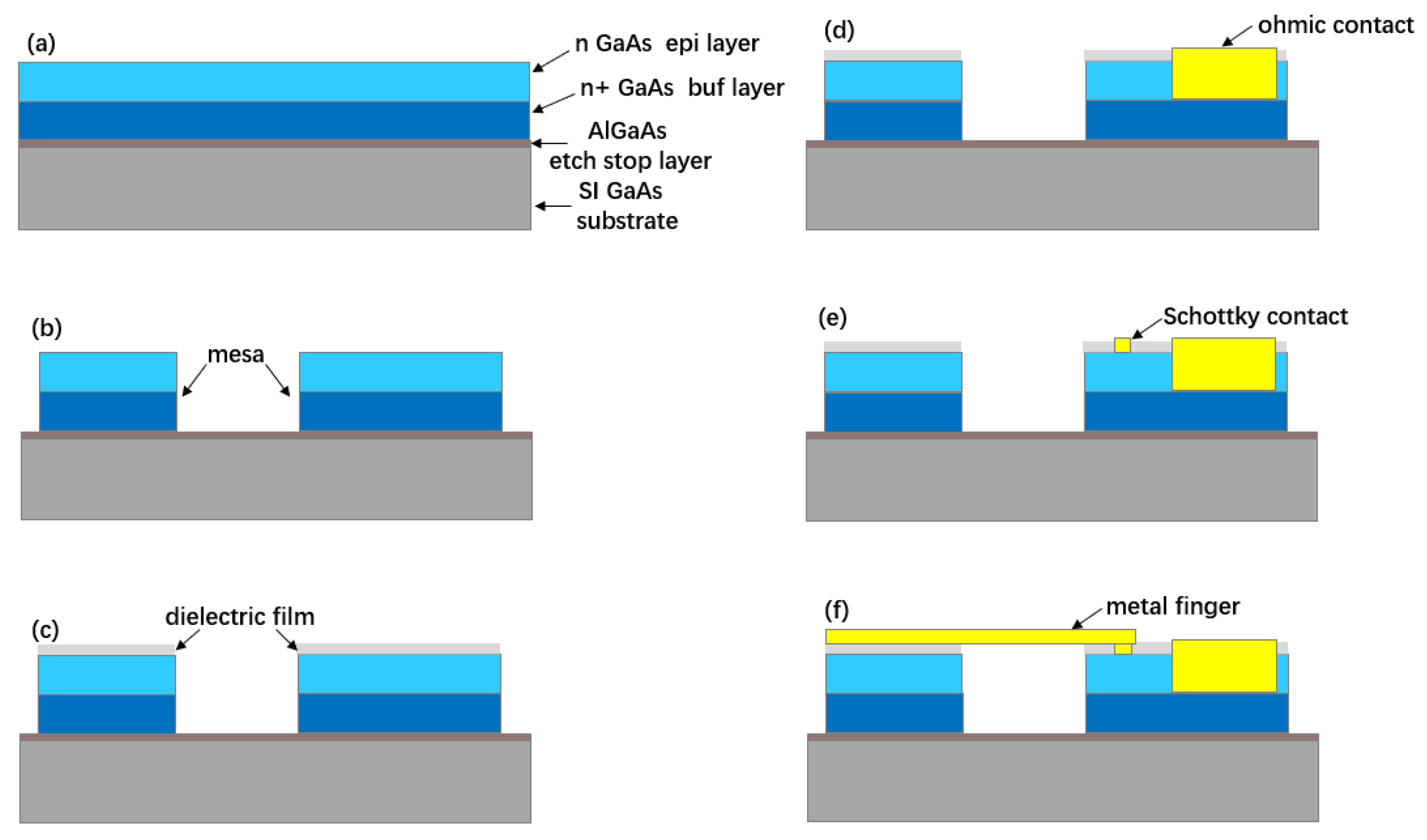

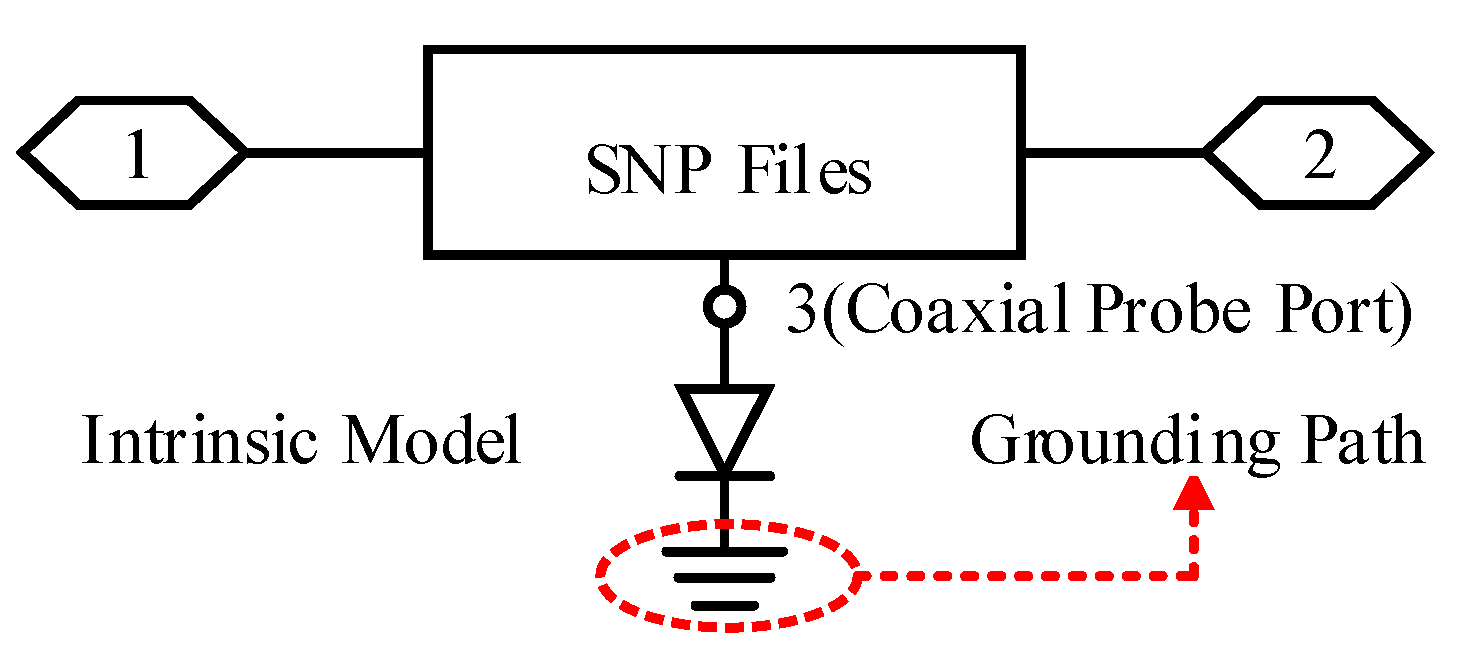


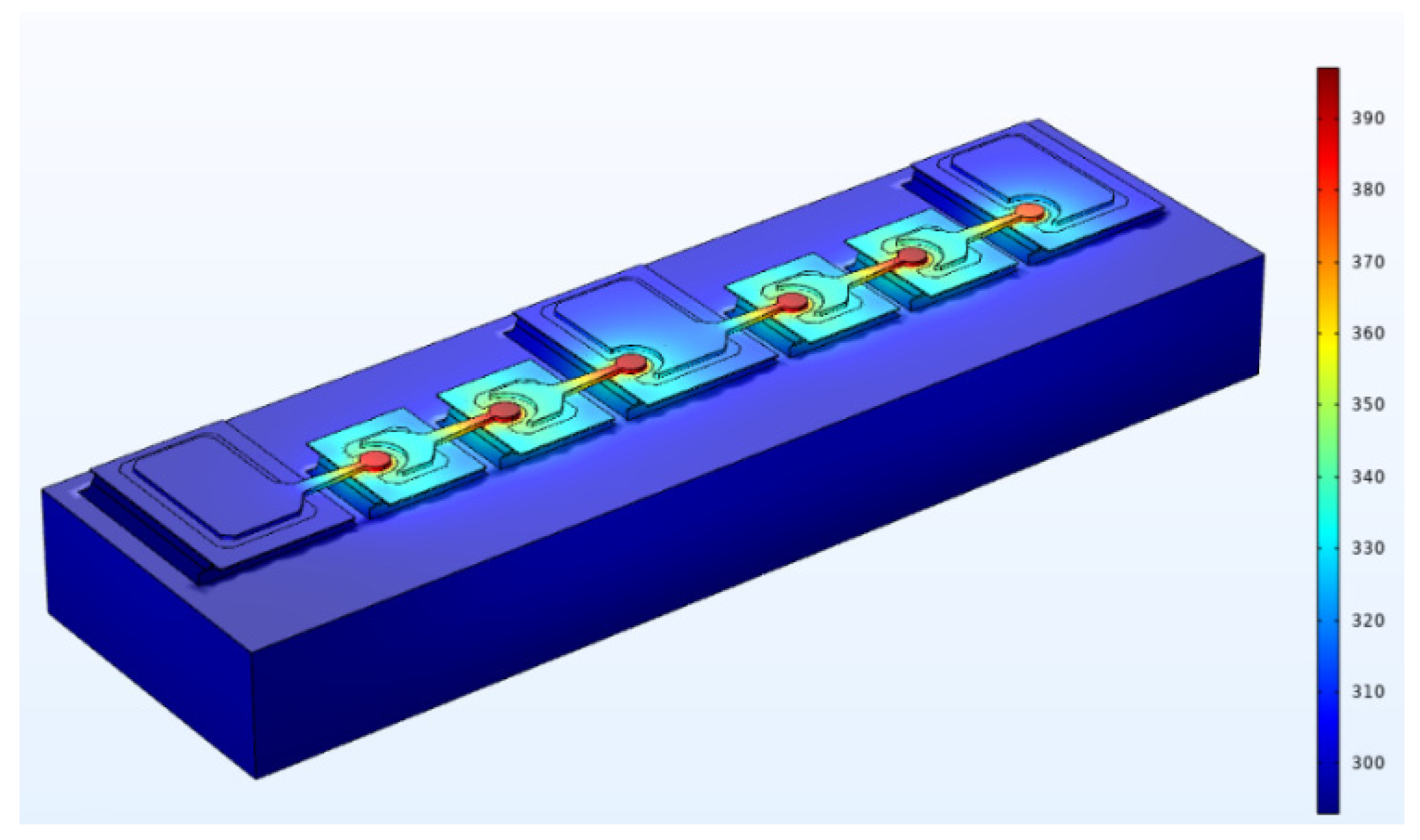

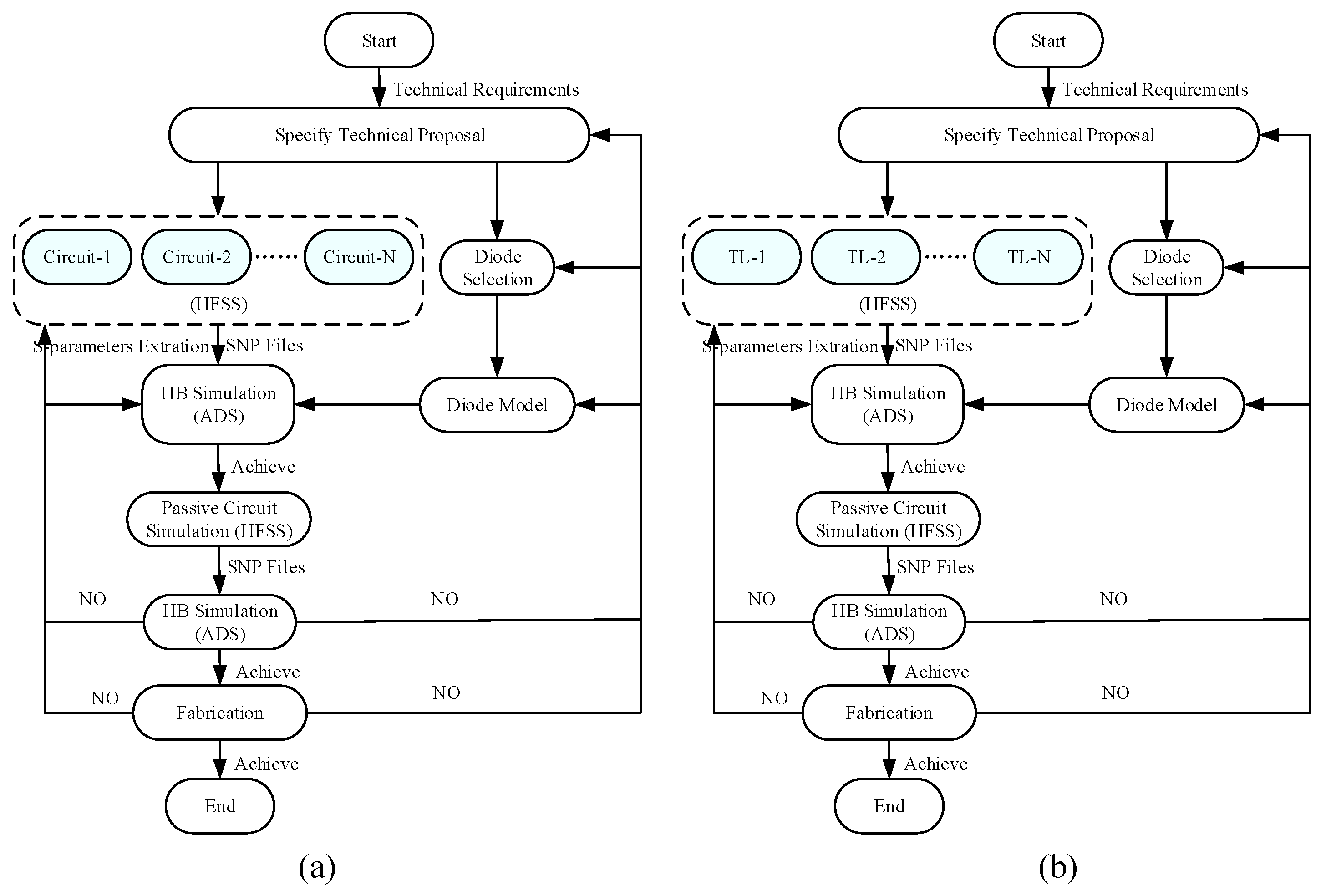

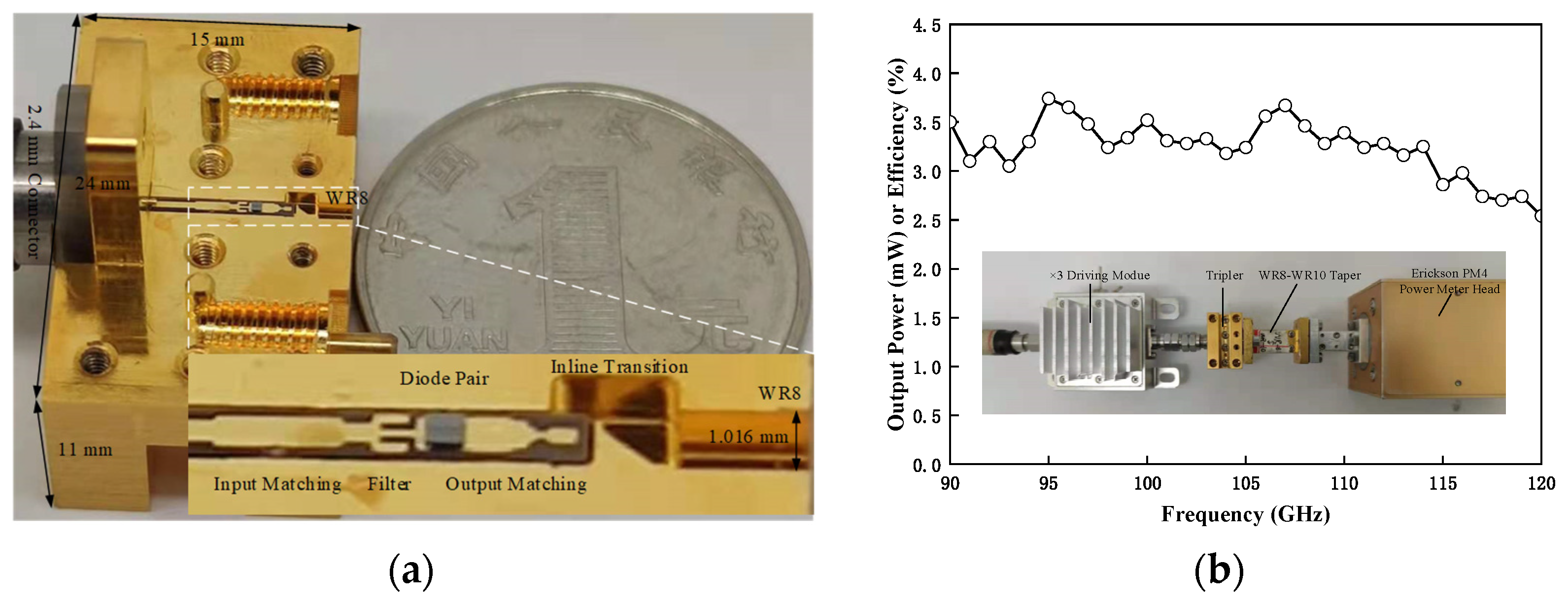
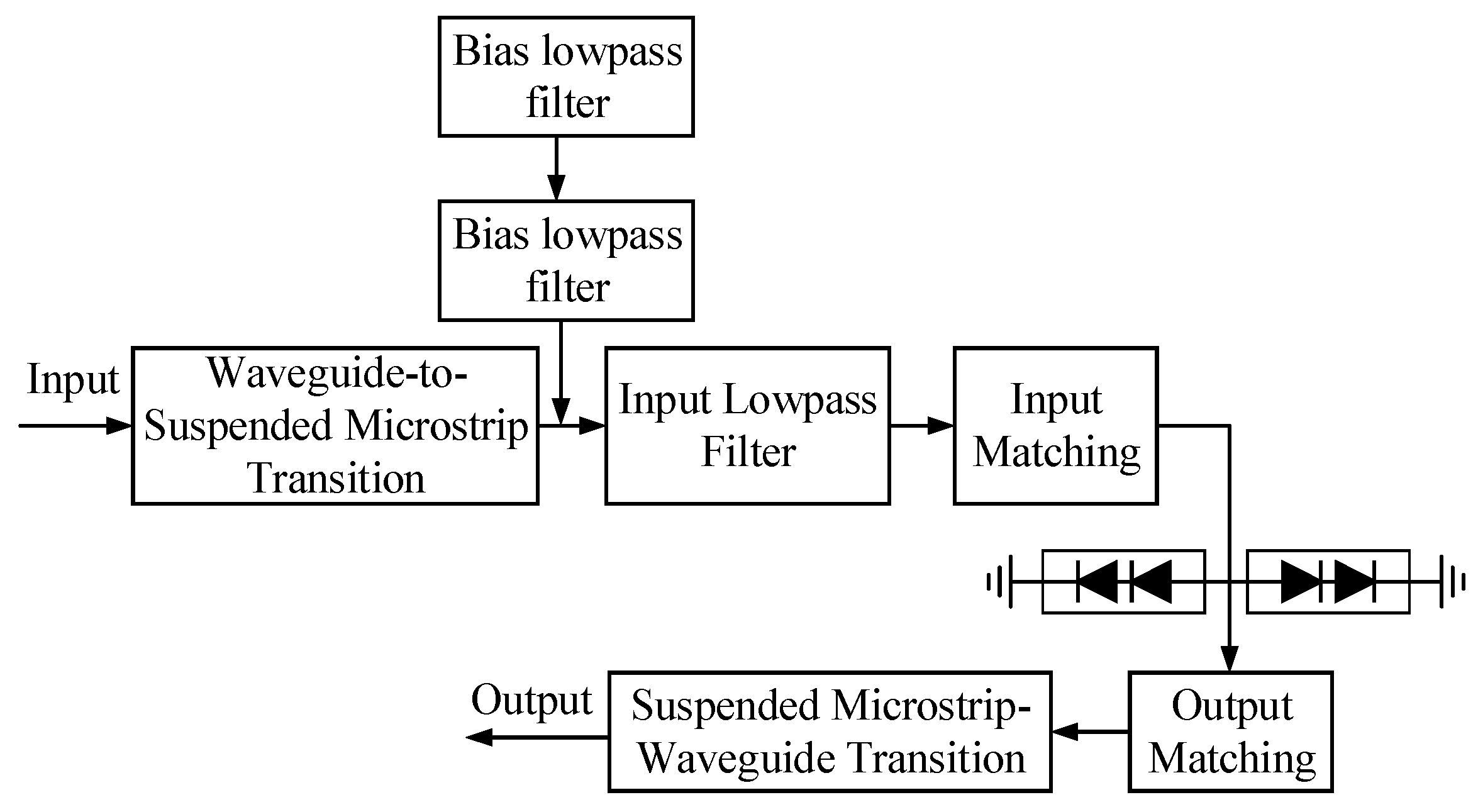


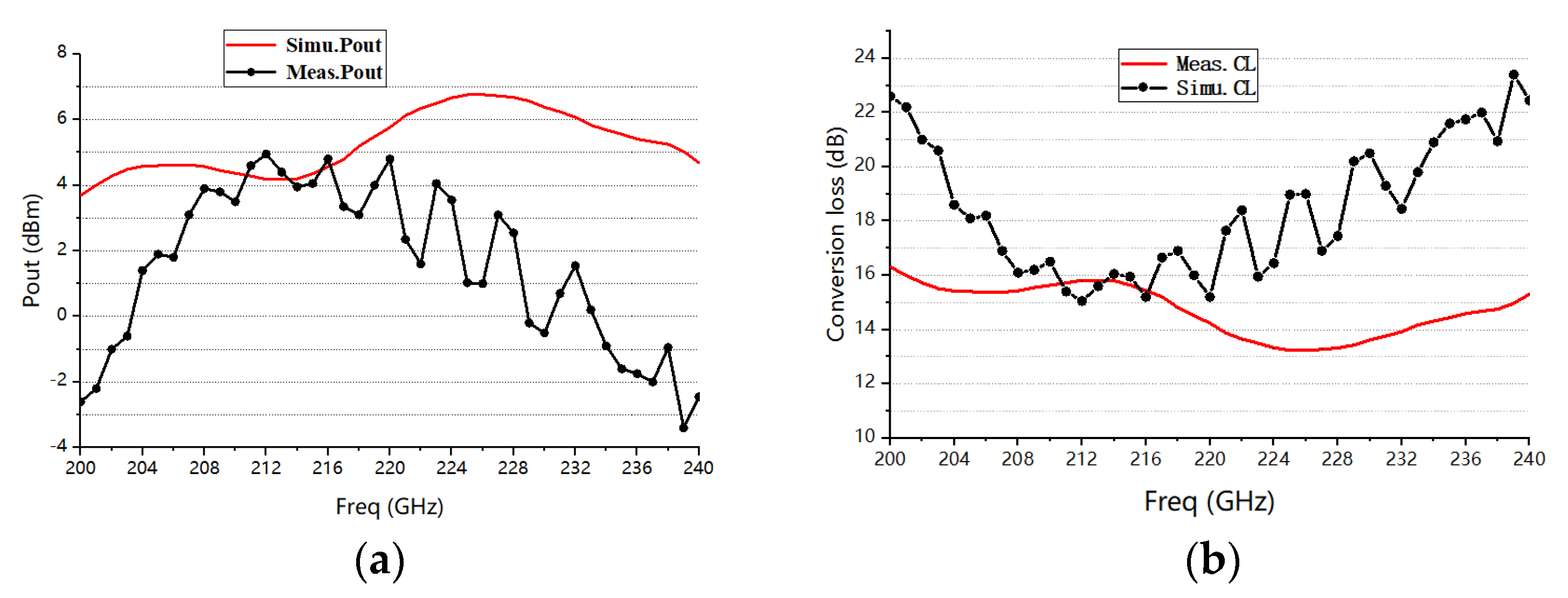

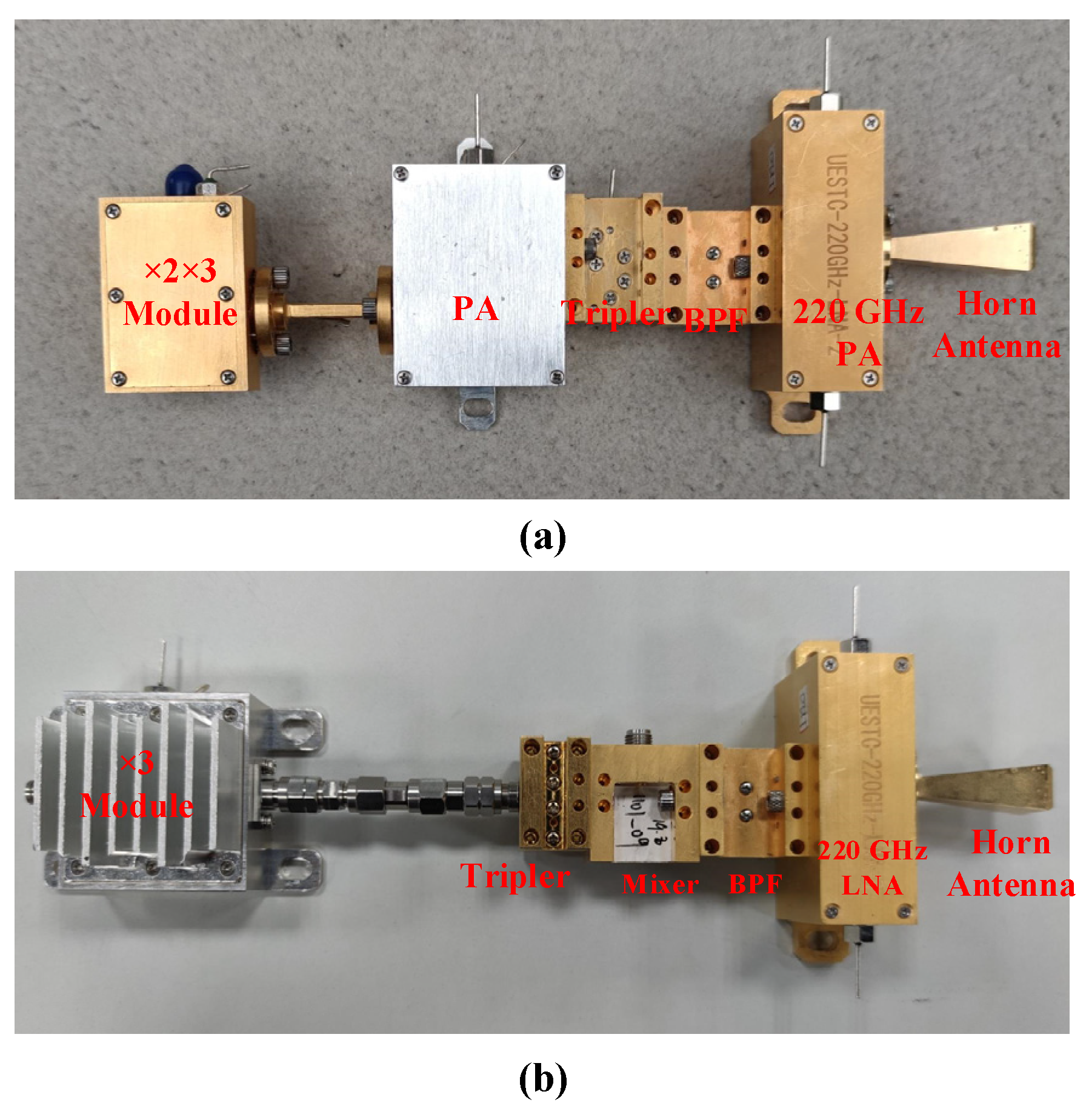
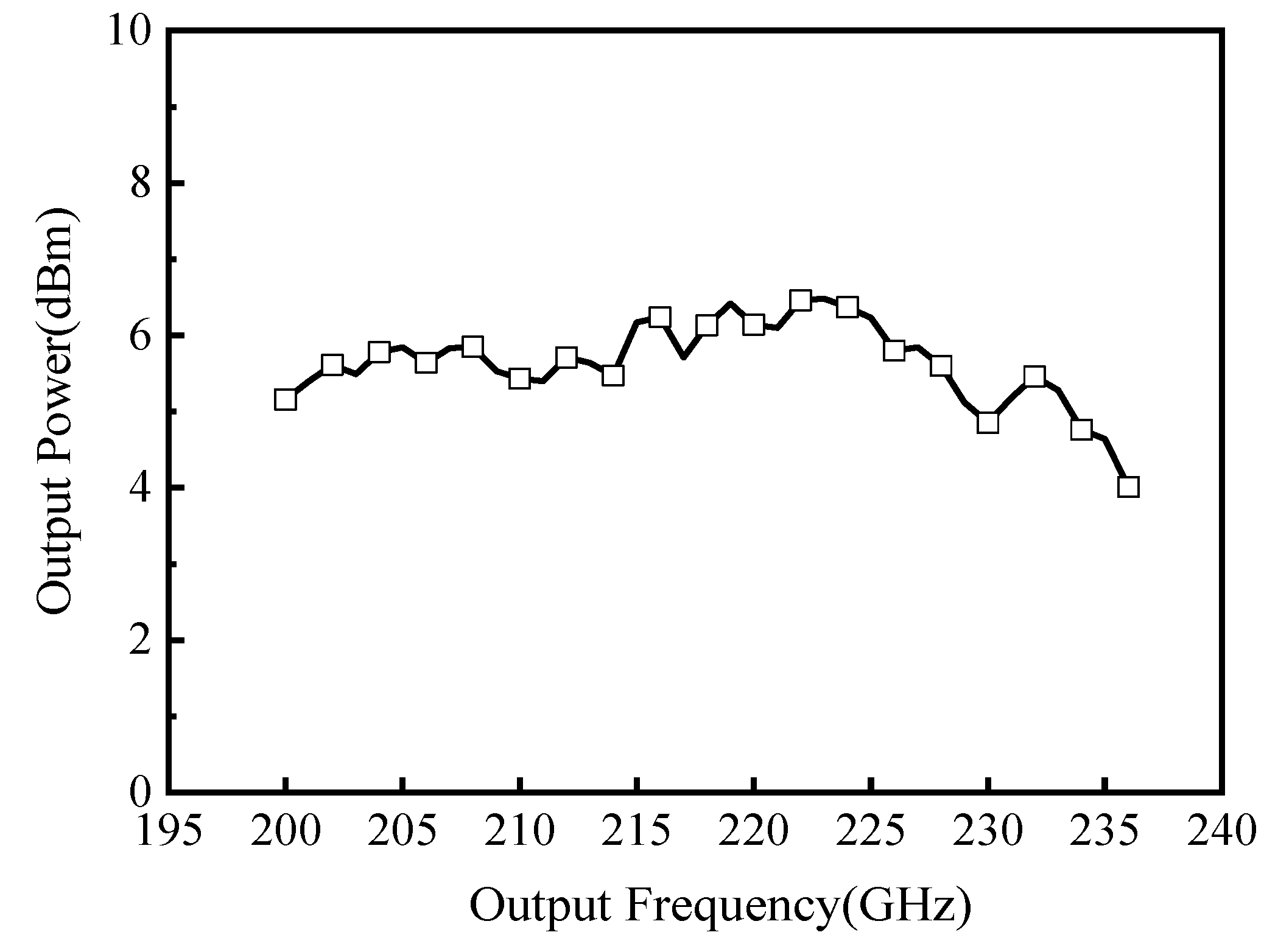
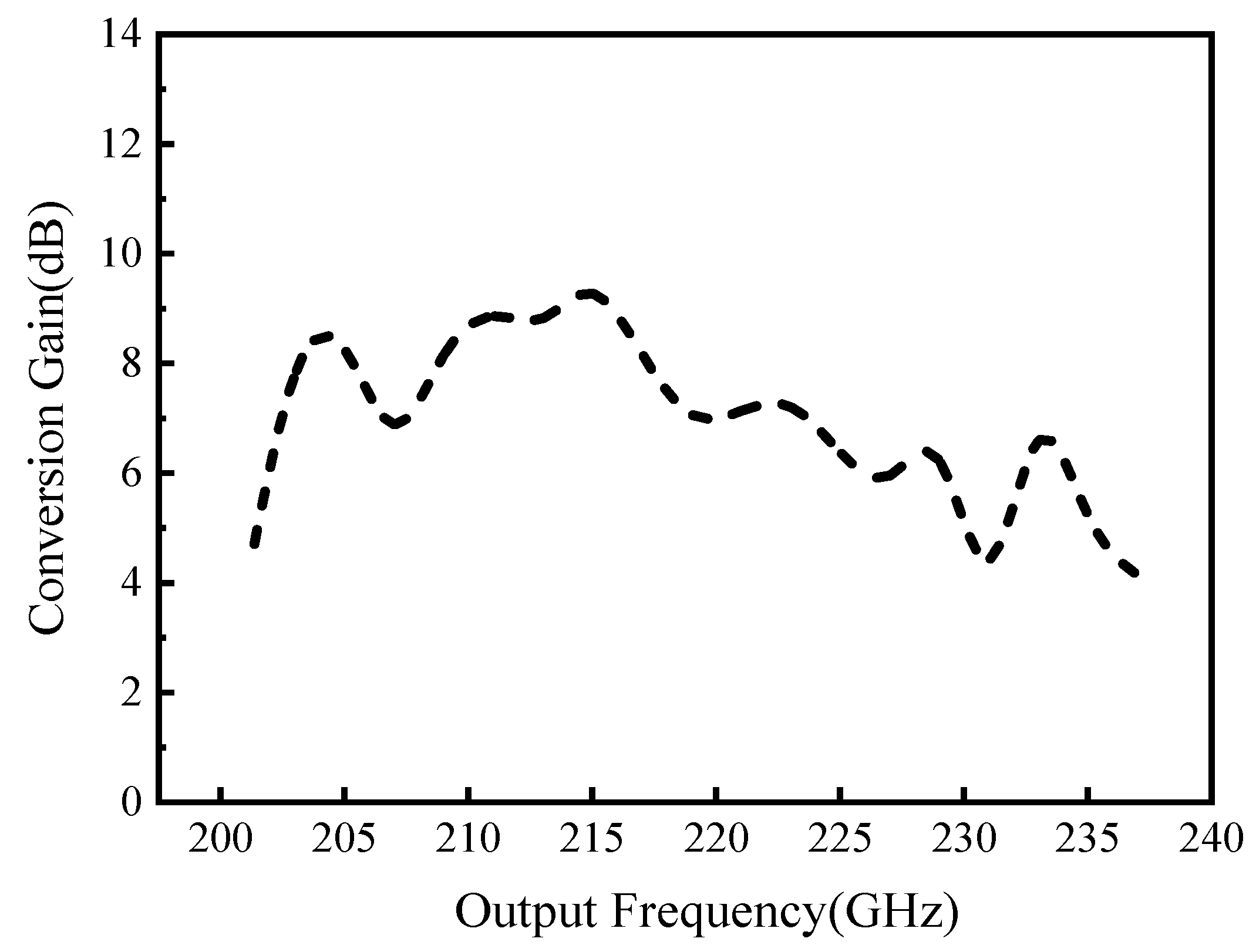
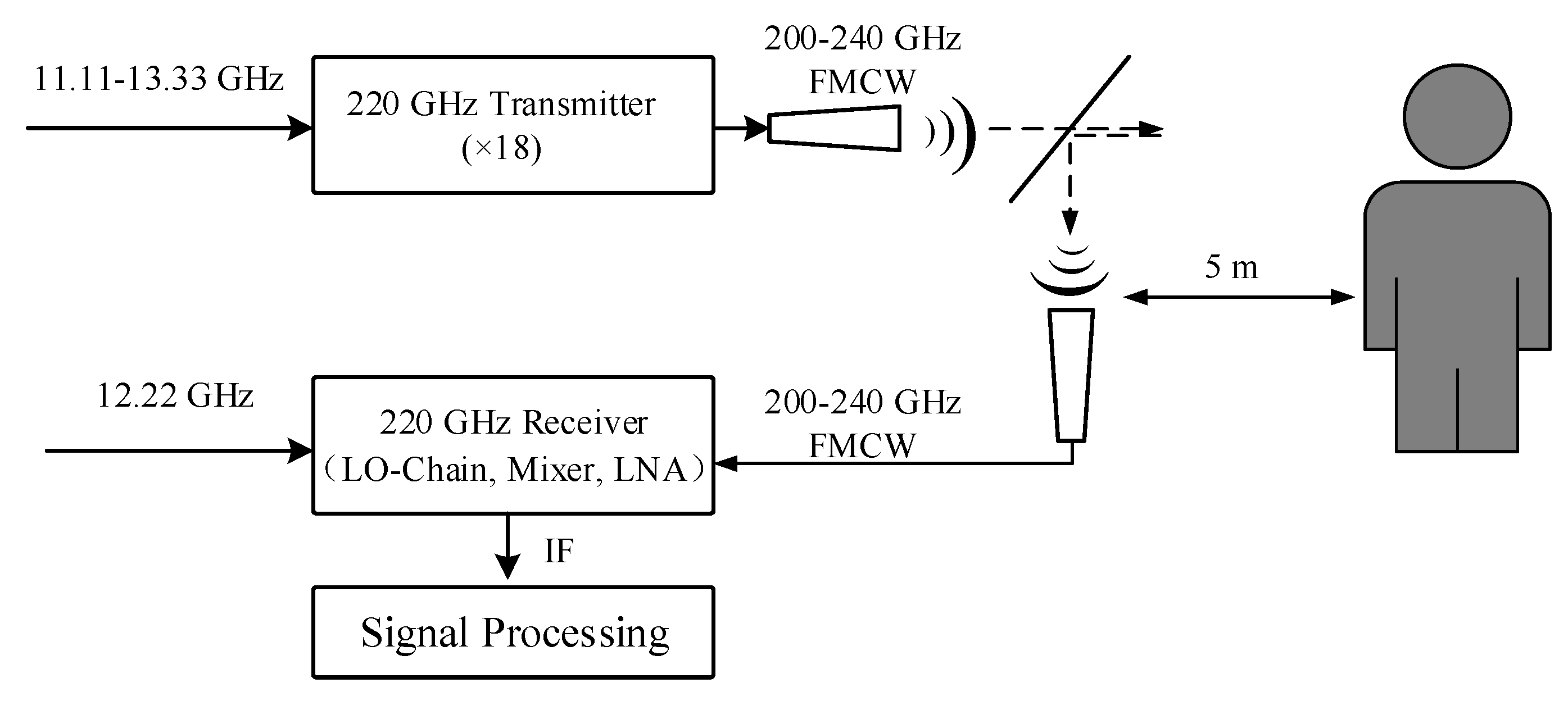
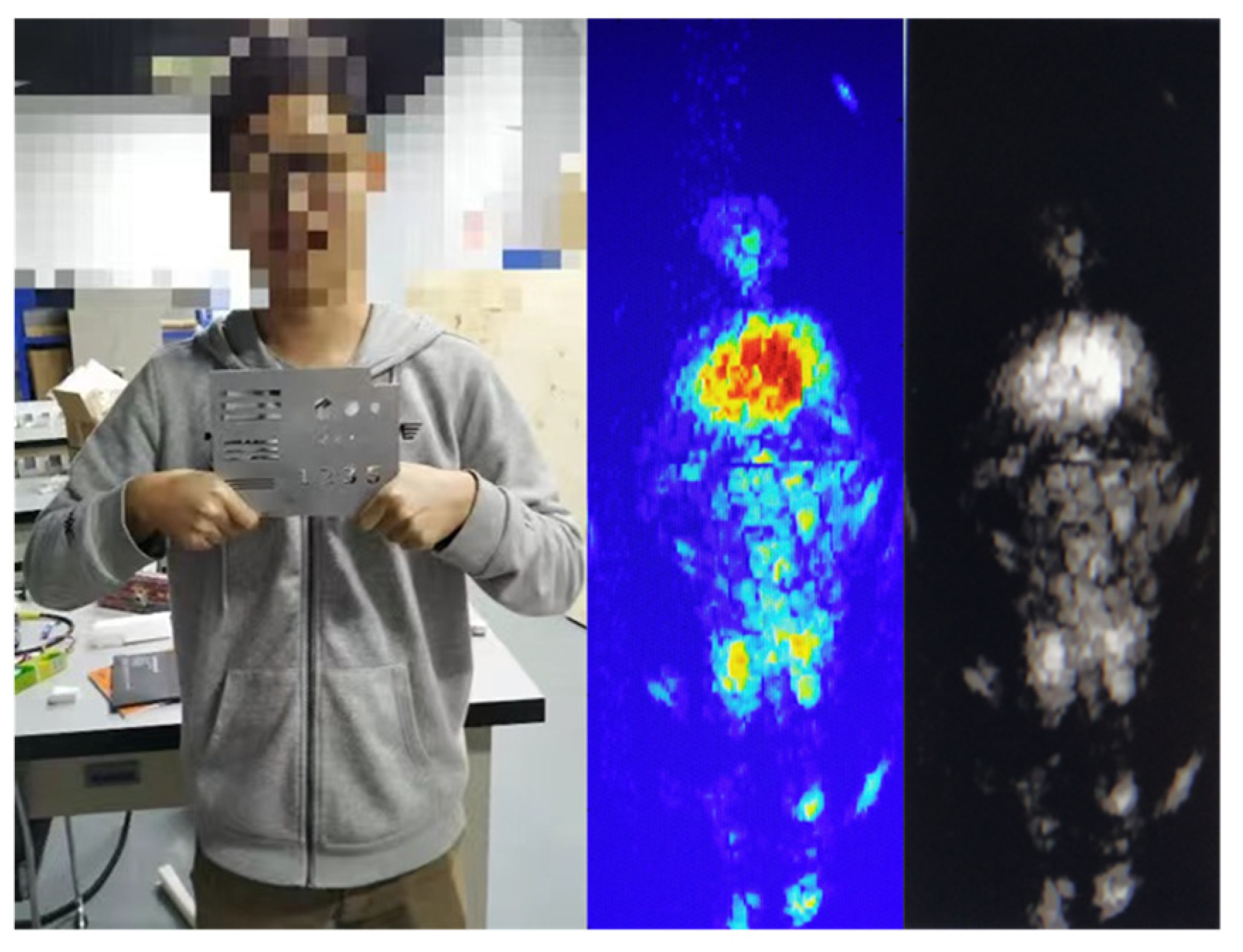
| Ref. | Freq. (GHz) | Harmonic | Pin (mW) | Peak Pout (mW) | Effi. (%) | FBW (%) | Device |
|---|---|---|---|---|---|---|---|
| [25] | 113 | ×3 | 1300 | 200 | 15 | 1.5 | HBVs |
| [26] | 282 | ×3 | 50–500 | 31 | ~7 | ~8.8 | HBVs |
| [50] | 135–190 | ×2 | 30–174 | 17.8 | 4–8 | 33.8 | GaAs SBDs |
| [51] | 165–200 | ×2 | 150–250 | ~100 | 40 | 20 | GaAs SBDs |
| [59] | 510–560 | ×3 | 350–400 | 30 | 8–9 | 11.3 | GaAs SBDs |
| [65] | 305–340 | ×2 | 15–33 | 3.5 | ~13.6 | 10.9 | GaAs SBDs |
| [66] | 177–183 | ×2 | 2000 | 200–244 | 9.5–11.8 | 3.3 | GaN SBDs |
| [69] | 150–170 | ×2 | 100–150 | 35 | ~25 | 10 | GaAs SBDs |
| [70] | 135–150 | ×3 | 50–70 | 3 | 3.9–4.9 | 10.5 | GaAs SBDs |
Publisher’s Note: MDPI stays neutral with regard to jurisdictional claims in published maps and institutional affiliations. |
© 2022 by the authors. Licensee MDPI, Basel, Switzerland. This article is an open access article distributed under the terms and conditions of the Creative Commons Attribution (CC BY) license (https://creativecommons.org/licenses/by/4.0/).
Share and Cite
Zhang, Y.; Wu, C.; Liu, X.; Wang, L.; Dai, C.; Cui, J.; Li, Y.; Kinar, N. The Development of Frequency Multipliers for Terahertz Remote Sensing System. Remote Sens. 2022, 14, 2486. https://doi.org/10.3390/rs14102486
Zhang Y, Wu C, Liu X, Wang L, Dai C, Cui J, Li Y, Kinar N. The Development of Frequency Multipliers for Terahertz Remote Sensing System. Remote Sensing. 2022; 14(10):2486. https://doi.org/10.3390/rs14102486
Chicago/Turabian StyleZhang, Yong, Chengkai Wu, Xiaoyu Liu, Li Wang, Chunyue Dai, Jianhang Cui, Yukun Li, and Nicholas Kinar. 2022. "The Development of Frequency Multipliers for Terahertz Remote Sensing System" Remote Sensing 14, no. 10: 2486. https://doi.org/10.3390/rs14102486
APA StyleZhang, Y., Wu, C., Liu, X., Wang, L., Dai, C., Cui, J., Li, Y., & Kinar, N. (2022). The Development of Frequency Multipliers for Terahertz Remote Sensing System. Remote Sensing, 14(10), 2486. https://doi.org/10.3390/rs14102486







